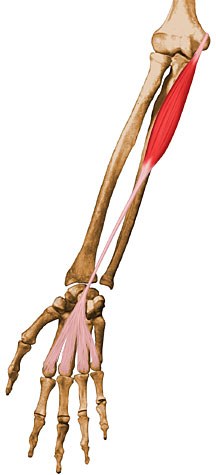Palmaris Longus: Difference between revisions
Mudra Shah (talk | contribs) No edit summary |
Mudra Shah (talk | contribs) No edit summary |
||
| Line 4: | Line 4: | ||
'''Top Contributors''' - {{Special:Contributors/{{FULLPAGENAME}}}} | '''Top Contributors''' - {{Special:Contributors/{{FULLPAGENAME}}}} | ||
</div> | </div> | ||
== | == Introduction == | ||
[[File:Palmaris-longus.jpg|thumb|<ref>Derek Moore. ''Palmaris Longus''. Available from: https://www.orthobullets.com/anatomy/10023/palmaris-longus [Accessed: 12 June 2018]</ref> Pictorial representation of an isolated Palmaris Longus muscle in the flexor compartment of the forearm]] | |||
The Palmaris longus muscle is a long, slender muscle which is usually present in the volar compartment of the forearm. It is usually seen as a small tendon intervened between the flexor carpi ulnas and the flexor carpi radialis muscles. | |||
However, it is currently accepted as a vestigeal muscle since studies have shown that almost 30% of the population could be lacking this muscle either in one forearm (unilateral) or both the forearms (bilateral) but the percentage can always vary. The peculiarity associated with this muscle is not merely its presence or absence, but it's high degree of anatomical variations even when present. | |||
== | == Description == | ||
== References == | |||
<references /> | <references /> | ||
[[Category:Anatomy]] [[Category:Muscles]] | [[Category:Anatomy]] [[Category:Muscles]] | ||
Revision as of 15:09, 12 June 2018
Original Editor -
Top Contributors - Mudra Shah, Mandeepa Kumawat, Nikhil Benhur Abburi, Manisha Shrestha and Admin
Introduction[edit | edit source]

The Palmaris longus muscle is a long, slender muscle which is usually present in the volar compartment of the forearm. It is usually seen as a small tendon intervened between the flexor carpi ulnas and the flexor carpi radialis muscles.
However, it is currently accepted as a vestigeal muscle since studies have shown that almost 30% of the population could be lacking this muscle either in one forearm (unilateral) or both the forearms (bilateral) but the percentage can always vary. The peculiarity associated with this muscle is not merely its presence or absence, but it's high degree of anatomical variations even when present.
Description[edit | edit source]
References[edit | edit source]
- ↑ Derek Moore. Palmaris Longus. Available from: https://www.orthobullets.com/anatomy/10023/palmaris-longus [Accessed: 12 June 2018]






